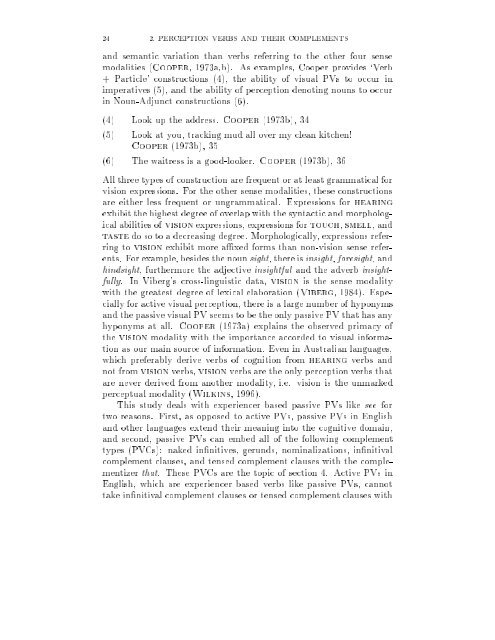Perception verb complements in Akatek, a Mayan language
Perception verb complements in Akatek, a Mayan language
Perception verb complements in Akatek, a Mayan language
You also want an ePaper? Increase the reach of your titles
YUMPU automatically turns print PDFs into web optimized ePapers that Google loves.
24 2. PERCEPTION VERBS AND THEIR COMPLEMENTS<br />
and semantic variation than <strong>verb</strong>s referr<strong>in</strong>g to the other four sense<br />
modalities (Cooper, 1973a,b). As examples, Cooper provides `Verb<br />
+Particle' constructions (4), the ability of visual PVs to occur <strong>in</strong><br />
imperatives (5), and the ability of perception denot<strong>in</strong>g nouns to occur<br />
<strong>in</strong> Noun-Adjunct constructions (6).<br />
(4) Look up the address. Cooper (1973b), 34<br />
(5) Look at you, track<strong>in</strong>g mud all over my clean kitchen!<br />
Cooper (1973b), 35<br />
(6) The waitress is a good-looker. Cooper (1973b), 36<br />
All three types of construction are frequent or at least grammatical for<br />
vision expressions. For the other sense modalities, these constructions<br />
are either less frequent or ungrammatical. Expressions for hear<strong>in</strong>g<br />
exhibit the highest degree of overlap with the syntactic and morphological<br />
abilities of vision expressions, expressions for touch, smell, and<br />
taste do so to a decreas<strong>in</strong>g degree. Morphologically, expressions referr<strong>in</strong>g<br />
to vision exhibit more a xed forms than non-vision sense referents.<br />
For example, besides the noun sight, there is <strong>in</strong>sight, foresight, and<br />
h<strong>in</strong>dsight, furthermore the adjective <strong>in</strong>sightful and the ad<strong>verb</strong> <strong>in</strong>sightfully.<br />
In Viberg's cross-l<strong>in</strong>guistic data, vision is the sense modality<br />
with the greatest degree of lexical elaboration (Viberg, 1984). Especially<br />
for active visual perception, there is a large number of hyponyms<br />
and the passive visual PV seems to be the only passive PV that has any<br />
hyponyms at all. Cooper (1973a) expla<strong>in</strong>s the observed primacy of<br />
the vision modality with the importance accorded to visual <strong>in</strong>formation<br />
as our ma<strong>in</strong> source of <strong>in</strong>formation. Even <strong>in</strong> Australian <strong>language</strong>s,<br />
which preferably derive <strong>verb</strong>s of cognition from hear<strong>in</strong>g <strong>verb</strong>s and<br />
not from vision <strong>verb</strong>s, vision <strong>verb</strong>s are the only perception <strong>verb</strong>s that<br />
are never derived from another modality, i.e. vision is the unmarked<br />
perceptual modality (Wilk<strong>in</strong>s, 1996).<br />
This study deals with experiencer based passive PVs like see for<br />
two reasons. First, as opposed to active PVs, passive PVs <strong>in</strong> English<br />
and other <strong>language</strong>s extend their mean<strong>in</strong>g <strong>in</strong>to the cognitive doma<strong>in</strong>,<br />
and second, passive PVs can embed all of the follow<strong>in</strong>g complement<br />
types (PVCs): naked <strong>in</strong> nitives, gerunds, nom<strong>in</strong>alizations, <strong>in</strong> nitival<br />
complement clauses, and tensed complement clauses with the complementizer<br />
that. These PVCs are the topic of section 4. Active PVs <strong>in</strong><br />
English, which are experiencer based <strong>verb</strong>s like passive PVs, cannot<br />
take <strong>in</strong> nitival complement clauses or tensed complement clauses with

















